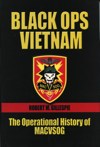 Black Ops Vietnam: The Operational History of MACVSOG, by Robert M. Gillespie, Naval Institute Press, 2011
Black Ops Vietnam: The Operational History of MACVSOG, by Robert M. Gillespie, Naval Institute Press, 2011
Through his use of many declassified documents, memoirs and secondary sources, author Robert M. Gillespie provides a very detailed and highly readable account of U.S. special operations during the Vietnam War in Black Ops Vietnam: The Operational History of MACVSOG. Gillespie sets up the story of the unit’s nine years of existence with a history of United States–backed covert anti-Communist operations in Vietnam in the 1950s. In 1961, although President John F. Kennedy continued to task the CIA with waging covert warfare against North Vietnam, the responsibility for these efforts began to shift from the CIA to the Pentagon.
It was in 1963 that the Joint Chiefs of Staff formalized plans for an ongoing program of covert action against North Vietnam. This included intelligence collection and psychological warfare operations, as well as air and naval attacks against North Vietnam. Military Assistance Command, Vietnam, Special Operations Group (MACVSOG, aka MACSOG, SOG) was formally activated in January 1964, as a joint task force with personnel primarily from the U.S. Army and Air Force but also from the Navy and Marine Corps. Its goal was to convince Hanoi to reduce or halt its support for the war in South Vietnam. The group’s name was soon changed to “Studies and Observations Group” (SOG), in an effort to better conceal its covert purpose. Although established by MACV, the Studies and Observation Group operated independent of it and was supervised by the Pentagon. Its commanders were Army Special Forces personnel, and it worked closely with CIA and South Vietnamese special operations forces.
Gillespie describes in great detail all manner of MACVSOG activities, from dramatic middle-of-the-night attacks on North Vietnamese radar installations to more mundane considerations of budgets, funding and logistics. It was an unconventional warfare force that employed military and paramilitary units, including indigenous forces, in guerrilla warfare.
At the beginning of the Vietnam War, few U.S. military personnel had any experience in the sort of activities assigned to MACVSOG. And throughout the war, the U.S. government constrained MACVSOG’s operations. These limitations were frustrating to the unit’s commanders, who wondered why it was necessary to keep their activities covert and restricted, when the Communists did not (for example, with respect to the neutrality of Laos and Cambodia).
As the war grew in its intensity and as more supplies were moved down the Ho Chi Minh Trail, interdiction became a top priority. Teams were dispatched into Laos, Cambodia and North Vietnam to gather information to be used in targeting airstrikes. In October 1967, MACVSOG had 275 U.S. personnel, mostly volunteers, and 7,615 South Vietnamese personnel. According to one study, MACVSOG achieved a 100-1 kill ratio. In nine years of fighting, 163 MACVSOG personnel were killed.
While Black Ops Vietnam offers a wealth of little-known information about this shadowy world, it contains only one map and has no photos of operations or equipment; it is mostly illustrated with headshots of various MACVSOG commanders. Perhaps that is a consequence of the covert nature of the unit. Likewise, its index is somewhat lacking as it excludes many terms that are found in the text and contains no Vietnamese personnel names.
The Studies and Observation Group was the largest project of its kind and its personnel were engaged in all aspects of the war. It had its critics, military and civilian, who felt its people were “undisciplined, wild-eyed Army Special Forces people…who believed that the whole of Southeast Asia could be conquered by a handful of Green Berets.” It ultimately failed to achieve its goals because of a basic flaw in American strategy: keeping Laos, Cambodia and North Vietnam off limits to ground attack. This failure was not for lack of trying on the part of MACVSOG, or for lack of courage and dedication on the part of its personnel. Gillespie’s book offers readers new insights into the organization, its operations and its personnel.
—Peter Brush




